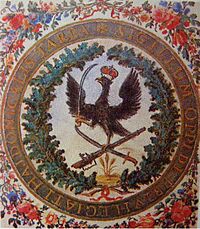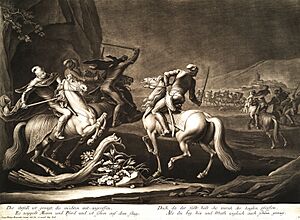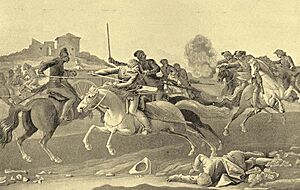Rákóczi's War of Independence facts for kids
Quick facts for kids Rákóczi's War of Independence |
|||||||
|---|---|---|---|---|---|---|---|
| Part of the War of the Spanish Succession | |||||||
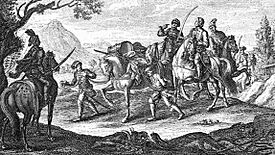 Kuruc horsemen captured an Austrian soldier |
|||||||
|
|||||||
| Belligerents | |||||||
|
Transylvanian Saxons Foreign mercenaries:
Swiss
Germans Italians Spaniards |
Minorities:
Hungarian Slovenes
Slovaks Rusyns Zipser Saxons Hungarian Germans Croats from Hungary Šokac and Bunjevac people Romanians in Hungary pro-Hungarian Serbs Foreign mercenaries and volunteers:
Poles
Wallachians Crimean Tatars Swedes Ottoman Turks Germans Lithuanians Moldavians Bulgarians Lipka Tatars Ruthenians |
||||||
| Commanders and leaders | |||||||
|
|
||||||
| Strength | |||||||
|
|
||||||
Rákóczi's War of Independence (1703–1711) was a major fight for freedom in Hungary. It was the first big effort to end the rule of the Habsburgs over the Hungarian kingdom. This war was led by Francis II Rákóczi, a nobleman, and involved other nobles, wealthy citizens, soldiers, and peasants. Even though the uprising did not fully succeed and ended with the Treaty of Szatmár, the Hungarian nobles gained some important rights.
Contents
Why the War Started
After the Treaty of Karlowitz in 1699, the Ottoman Empire gave up most of its lands in Hungary. These lands had been taken from the medieval Kingdom of Hungary after 1526.
Hungarian nobles were unhappy with Habsburg rule. They could only get their lands back if they proved ownership and paid 10% of the land's value to the Habsburgs. If they couldn't pay, the land went to the Empire's creditors.
Peasants also suffered greatly from the long wars. They faced many hardships. In 1697, an uprising against the Habsburgs in Tokaj was stopped. Relations between the Habsburg rulers and the Hungarian people became very bad. Some even wished for the Ottomans to return.
Earlier Uprisings
Hungary saw a chance to become free from the Habsburgs. In 1678, rebels led by a young nobleman named Imre Thököly rose against the Empire. They had help from King Louis XIV of France. Thököly took control of most of Northern Hungary.
In 1681, the Ottomans joined to help Thököly. Sultan Mehmed IV even recognized him as King of Upper Hungary. However, when the Ottomans lost the Battle of Vienna in 1683, Thököly lost their support. He was finally defeated in 1685.
His alliance with the Ottomans changed how Western Europe saw Hungary. Instead of being seen as a protector of Christianity, Hungary was now viewed as an enemy. Because of this, Hungary was treated as "newly acquired territory" rather than "land freed from the Ottomans."
Francis II Rákóczi: The Leader
Francis II Rákóczi (in Hungarian: II. Rákóczi Ferenc) came from an old noble family. He was one of the richest landowners in the Kingdom of Hungary. From 1694, he was the count of Sáros County.
Rákóczi was born in 1676. His father was Francis I Rákóczi, who had been a ruling prince of Transylvania. His mother was Ilona Zrínyi. Rákóczi's father died when he was a baby. In 1682, his mother married Imre Thököly.
After Thököly's defeat, Rákóczi's mother held the castle of Munkács (now Mukacheve in Ukraine) for three years. But she eventually had to give up. After the Treaty of Karlowitz, Rákóczi had to stay in Vienna under Habsburg watch. His stepfather and mother were sent away.
The Start of a New Rebellion
Parts of Thököly's peasant army began a new uprising. This happened in the Hegyalja region of northeastern Hungary, which was part of the Rákóczi family's land. They captured the castles of Tokaj, Sárospatak, and Sátoraljaújhely.
They asked Rákóczi to lead them, but he was not eager to head what seemed like a small peasant revolt. He quickly went back to Vienna to clear his name. There, Rákóczi became friends with Count Miklós Bercsényi. Bercsényi was married to Krisztina Csáky. His land was next to Rákóczi's.
Bercsényi was a very smart man. He was the third richest person in the kingdom. He was also related to most of the Hungarian noble families.
The Fight for Independence Begins
The House of Habsburg was facing problems, and France wanted allies against Austria. So, France contacted Rákóczi. They promised to help if he fought for Hungarian independence.
An Austrian spy found out about their letters. The spy showed them to the Emperor. Because of this, Rákóczi was arrested on April 18, 1700. He was put in prison in the fortress of Wiener Neustadt, south of Vienna. It seemed clear that he would be sentenced to death, like his grandfather Péter Zrínyi.
With help from his pregnant wife, Amelia, and the prison commander, Rákóczi escaped. He fled to Poland. There, he met Bercsényi again, and they reconnected with the French court.
The Uprising Gathers Strength
Three years later, the War of the Spanish Succession began. This war caused many Austrian soldiers to leave Hungary. Rákóczi saw this as a chance. Kuruc forces started a new uprising in Munkács, and they asked Rákóczi to lead it. He decided to fight for national freedom and accepted.
On June 15, 1703, about 3,000 armed men joined him near the Polish city of Lawoczne (now Lavochne, Ukraine). This group was led by Tamás Esze. Bercsényi also arrived with money from France and 600 Polish soldiers.
Most Hungarian nobles did not support Rákóczi's uprising at first. They thought it was just a peasant rebellion. Rákóczi's call to the nobles of Szabolcs County seemed to fail. However, he convinced the Hajdús (freed peasant warriors) to join his forces. By late September 1703, his forces controlled most of Hungary east and north of the Danube River. Soon after, they also took over Transdanubia.
Challenges and Negotiations
The Austrians had to fight Rákóczi on several fronts. This made them willing to talk peace. But then, Austrian and English forces won a big victory against a French-Bavarian army at the Battle of Blenheim on August 13, 1704. This win helped them in the War of the Spanish Succession. It also stopped Rákóczi's forces from joining their French-Bavarian allies.
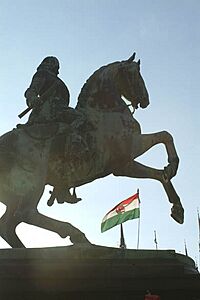
This put Rákóczi in a tough spot, both militarily and financially. French support slowly decreased. He needed a larger army to hold the land they had won. But he couldn't afford to supply his current army with enough weapons and food. He tried to fix this by making new copper coins. However, people in Hungary were used to silver coins, so the copper ones were not easily accepted.
Still, Rákóczi kept his military advantage for a while. But after 1706, his army was forced to retreat.
Political Moves and Setbacks
In September 1705, a meeting of the Hungarian Diet (a type of parliament) was held near Szécsény. Rákóczi was elected as the "fejedelem" (ruling prince) of the Confederated Estates of the Kingdom of Hungary. A 24-member Senate was created to help him. Rákóczi and the Senate were in charge of foreign affairs, including peace talks.
England and the Netherlands encouraged new peace talks. These began on October 27, 1705, between the kuruc leaders and the Emperor. But fighting continued, and both sides changed their plans based on how the war was going. On December 13, Kuruc forces led by János Bottyán defeated the Austrians at Szentgotthárd.
One big problem was who would rule Transylvania. Neither side wanted to give it up. Rákóczi's plan for a treaty with France was stuck. He became convinced that only a declaration of independence would make other countries willing to negotiate with him. In 1706, his wife and sons, whom he hadn't seen in five years, were sent as peace messengers. But Rákóczi rejected their efforts for the Emperor.
On Rákóczi's advice, and with Bercsényi's help, another Diet meeting was held at Ónod in June 1707. They declared that the House of Habsburg was no longer the ruler of Hungary. But this act, and the copper money he issued, did not work. Louis XIV refused to make treaties with Prince Rákóczi, leaving the Hungarians without allies. An alliance with the Russian Tsardom was possible, but it never happened.
The End of the Uprising
At the Battle of Trenčín (now in Slovakia) on August 3, 1708, Rákóczi's horse stumbled. He fell and was knocked out. The kuruc soldiers thought he was dead and ran away. This defeat was a huge blow to the uprising. Many Kuruc leaders then switched sides to the Emperor, hoping to be forgiven.
Rákóczi's forces were left with only the areas around Munkács and Szabolcs County. He did not trust János Pálffy, the Emperor's envoy who was supposed to talk with the rebels. So, on February 21, 1711, Prince Rákóczi left Hungary and went to Poland.
Who Fought in the War?
Denmark-Norway
Denmark–Norway sent soldiers to the Habsburg army every year. These Danish regiments were stationed in Hungary. This meant Danish soldiers fought alongside the Habsburg army against the Hungarians (Kurucs) and their allies. Danish forces fought in Eastern Hungary and Transylvania, including the Battle of Zsibó.
Serbs, Croats, and Saxons
The Serbs, who had settled in Hungary's southern borders and were protected by the Austrians, fought for the Emperor from the start. They served as light cavalry in the Austrian army and helped collect taxes. During the war, Serb forces burned and robbed Hungarian villages in the Great Hungarian Plain and Transdanubia. In Bácska, Serb villages were also burned. However, some Serbs, like the Frontiersmen of Semlak, fought with Rákóczi against the Habsburgs. Their leader was Frontier Captain Obrad Lalić from Zenta.
Croatia also supported the Habsburg Monarchy. The Croatian Army and Habsburg troops stopped the Kurucs from taking over Croatia. Croatian and Serbian forces fought in Transdanubia and Upper Hungary. The Transylvanian Saxons also did not support Rákóczi in 1703. Even though Austrian General Rabutin lost in Transylvania, he retreated to Saxonland. There, Saxon towns and peasants gave shelter to the Habsburg Army. Fights between the Kuruc and Habsburg-Saxon armies happened throughout Croatia.
Romanians and Slovaks
During the conflict, many Slovaks fought for Rákóczi. The Kuruc army had Slovak commanders, and some Kuruc units were entirely Slovak. After Transylvania gained more freedom, the Romanian people largely supported the Kurucs. A few hundred soldiers from Wallachia and Moldavia also fought in Rákóczi's army.
Other Fighters
Many Polish volunteers and hired soldiers came from Poland. Many soldiers were also Ukrainians and Lipka Tatars, who supported the Kurucs. Rákóczi often asked Poland for help and tried to get more Polish soldiers.
In Hungary, the German Spiš Saxons and some other German groups, including soldiers who left the Habsburg Army, joined Rákóczi's war. They were joined by German mercenaries. The Kuruc Army even used commands and oaths in both Slovak and German, because so many Germans and Slovaks served in their army.
The Rusyn people quickly joined the uprising in 1703. Even before that, between 1690 and 1702, the Rusyns had supported the Hungarians against Austrian soldiers. The Hungarian Slovenes from the regions of Muraszombat, Lendva, and Szentgotthárd also fought against the Habsburg soldiers. This was because the Styrian forces often took supplies from Slovene villages.
A few hundred Swedish soldiers who had left the Battle of Poltava and other places joined Rákóczi in Hungary. In 1710, Rákóczi allowed these Swedes into his army, which was losing hope. The combined Hungarian-Polish-Swedish-French army almost won against the Austrians in the Battle of Romhány. However, Rákóczi's last forces were crushed by an Austrian counterattack.
Rákóczi's army also included soldiers from Bulgarians, Lithuanians, Crimean Tatars, and Ottomans.
See also
- Simontornya Castle, used as a stronghold by Kuruc rebels


